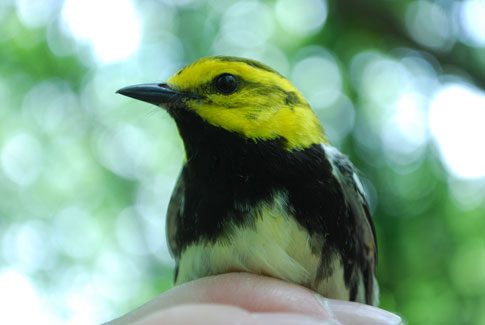Black-throated green warblers

I’ve traversed some rugged country in the Uwharries. My dad and I have bushwhacked through laurel thickets and scrambled up and down steep and slippery slopes to blaze trails and mark property lines. In general, though, our land is more accessible than isolated coves in the mountains or impenetrable swamps at the coast. And yet we often have better records of natural communities in those areas. Generations of naturalists have suffered mightily to document species in the geographic extremes of the state.
Today, many people believe the Piedmont has been so thoroughly altered that nothing special is left. People also assume we already know everything we need to know about the Piedmont. Legions of grad students at Carolina, Duke and State have studied every inch of the Triangle, so why bother with the Uwharries?
But gaps in our knowledge are all too common. One example is the entry for the black-throated green warbler in the otherwise excellent field guide Birds of the Carolinas by Potter, Parnell, Teulings and Davis. The black-throated green is about the size of your palm. It has a black throat, bright yellow face, olive-green back and white wing bars. Even when I can’t see it, I can usually identify its song, a buzzy zee zee zee zoo zee. Sometimes it sings a slower variation that sounds like trees, trees, murmuring trees. Black-throated greens winter in warmer climates, from Mexico to Colombia, but they return each spring to breed at high elevations in the Southern Appalachians and points north into the boreal forests of Canada. A separate population also breeds in the coastal plain of NC, SC and VA. According to the book, black-throated greens pass briefly through the Piedmont during migration. In fact, some stay and breed in the Uwharries.
This summer, Dr. Joe Poston, a professor at Catawba College, has been studying our local black-throated greens. He goes out before sunrise and sets up a mist net. To attract the birds, he plays a recording of their song, inciting males to defend their territory and inspiring females to check out a new suitor. Instead, they get snagged in the net. Dr. Poston carefully untangles the birds, takes measurements and feather samples, attaches an aluminum leg band then sends the birds back to their mating and nesting.
He has focused on the highest peaks in the Uwharries. In addition to the known habitat on Morrow Mountain, he has found birds on other mountains, including Daniel and Shingletrap in the Badin Recreation Area. Our black-throated greens nest on northern slopes, which are moister and have slightly different plant communities. Next season Dr. Poston hopes to use radio transmitters to track the birds and learn more about their habitat preferences.
In the meantime, he is working with John Gerwin at the NC Museum of Natural Sciences to make genetic comparisons to the other populations in the state. The results will tell us if our black-throated greens in the Uwharries are closer relatives of their kinfolk in the mountains or at the coast. And maybe one day this information will appear in a future edition of the field guide.
This article first appeared in The Montgomery Herald in Troy, NC, and is republished here with permission of the author and the newspaper.
Photo by Dr. Joe Poston, Catawba College.